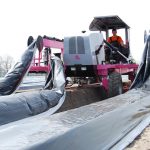 Towards the back end of last year I wrote about some new innovations in the field of automated plant management, and the growing number of robots that are capable of planting and tending to plants automatically.
Towards the back end of last year I wrote about some new innovations in the field of automated plant management, and the growing number of robots that are capable of planting and tending to plants automatically.
Suffice to say, the devices are often rather clumsy and can not always detect a ripe item from an unripe one, which typically results in a human helping working alongside them. This is a challenge that researchers are working hard to overcome.
Selective harvesting
The team are working specifically around the successful harvesting of cauliflower, which presents a particular challenge due to the nature and appearance of the vegetable.
Human pickers typically have to pull back a protective leaf to look and see if the head is ripe for harvesting. This can be a particularly laborious job that can take several days to cover an entire field. The tough nature of the job, together with the short-term aspect of the gig means finding workers to perform the role is difficult.
The team developed their machine, which they’ve dubbed VitaPanther, aims to provide a number of benefits to farmers, including speed of picking and a 24/7 operation.
“Farming is the last profession in which the necessary profits can only be made with a large workforce. Automation is essential for us farmers, because the minimum wage is making vegetable harvesting unfeasible. Harvesting is sustained by two components: the availability of a seasonal workforce and the pay. A shift in one of these components jeopardizes the structure. The demand for technology is thus very great,” they say.
Image detection
Central to the success of the device is its ability to detect the ripeness of the vegetable in an easy and effective way. The machine encompasses sensors to detect a range of factors together with algorithms to make sense of the data.
“We are taking advantage of an effect we discovered in preliminary tests: The leaves of ripe cauliflower have a different biochemical composition than those covering unripe heads,” they say.
This is achieved by scanning the heads of the cauliflower with a super-sensitive camera that detects a range of wavelengths that are beyond normal human vision. A smart model is applied to these images to determine the biochemical composition of the leaves, which in turn allows the ripeness to be inferred.
The model is based on a machine learning approach whereby the algorithm was training on a catalog of examples of human pickers manually inspecting each cauliflower.
This then provides the machine with a simple yes-no command for harvesting or not that allows for autonomous picking, even when the heads of the cauliflower are unfamiliar.
The team believe this approach could be used for a number of other vegetables, including asparagus and lettuce, thus meaning farmers only need to purchase a single machine for all of their needs.
It’s a little way from market yet, but is certainly a trend to watch with interest.